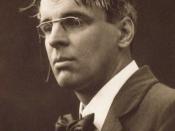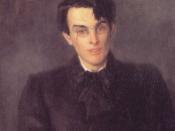The Second Coming is a free-verse poem of 23 lines. It is a description of the world as Yeats sees it at that moment in time (1919). The poem is about the world being brought to its knees by anarchy and how the second coming is at hand. It symbolizes the beginning of an era and the ending of another. The poem is wrought with Biblical references. This comes as a surprise as Yeats found it hard to believe in Christianity, and like his father, believed in the religion of art. He searched for meaning in mysticism, folklore (being Irish) and theology amongst others. It is surprising then that this poem - taking its name and content from a biblical perspective - has so many religious references. It shows that even though Yeats might not have been an active Christian he certainly knew the fundamentals. The beast that is born in the desert in the poem is not what Yeats refers to when he speaks of the second coming.
The 'rough beast' that is born is a symbol of death, with the 'indignant desert birds' circling above, and not the coming of Christ - this will happen later. It seems as if the poem is a commentary trying to warn the public about the sins of the world. Repeating elements in the poem are the cycle of things, anarchy, defeat and hopelessness. All these aspects of the poem must be discussed in greater detail.
Turning and turning in the widening gyre 1
The first line introduces the theme of cyclical movement, which Yeats thought to be the way in which period of history began and ended. The main age that Yeats is referring to is that of the time between the death of Christ, and the time of the Second...


